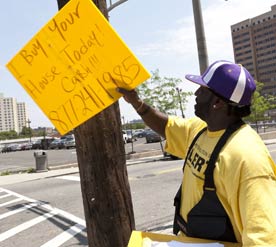
Legends South, a Chicago Housing Authority mixed-income development. Photo by David Schalliol
Before White House press secretary Robert Gibbs lashed out at the “professional left” in frustration over what the White House views as an insatiable quest from the left for ideological purity, it’s unlikely that he, or the White House, would have thought they might run into ideological differences related to preserving public housing. President Obama is a Democrat after all, with solid public housing bona fides; he hails from Chicago, home to some of the earliest public housing efforts in the country; and Shaun Donovan, the president’s pick to head the U.S. Department of Housing and Urban Development, is an exceedingly accomplished houser, bringing credibility to HUD.
And yet, the administration’s $350 million effort to reform public housing, the Preservation, Enhancement and Transformation of Rental Assistance Act (PETRA) is being depicted as “a more extreme version of George W. Bush’s Public Housing Reinvestment Initiative” that would represent a “formal divestment and the end of public housing that residents have called home for over seven decades,” in written testimony by a group of urban affairs academics submitted to the House Committee on Financial Services. In more moderate terms, it is still being seen as “at best a work in progress with many reasons for concern by low income housing tenants and advocates,” as Sheila Crowley, president of the National Low Income Housing Coalition, wrote on her organization’s blog.
The initiative, first proposed in February 2010, seeks to help federal housing programs to leverage other, mostly private, capital by converting public housing and existing HUD-assisted housing to a new form of project-based contract. In the first year, they hope this would leverage $7 billion, and eventually as much as $25 billion, according to HUD estimates. PETRA would also consolidate various rental assistance programs and wait lists and encourage regional mobility for voucher holders.
But concerns abound, from the specific and short-term — PETRA’s absence of a cap on the interest rate that lenders can charge housing authorities — to the big-picture and long-term — What happens if lenders foreclose? If a subsequent president or Congress has less concern for public housing, are there guarantees that the new, higher subsidies will still be available in perpetuity?
In an interview with Shelterforce, HUD Assistant Secretary for Public and Indian Housing Sandra Henriquez responds to these and many of the other concerns presented here, in a dialogue that is proving to be veritable intrasquad match between people who are all very much staunch housing advocates. The question at hand is, happily, not whether to preserve public housing, but how. This is good news, particularly when, in the last 15 years, the United States has lost about 150,000 public housing units to sale or demolition, on top of another 360,000 privately owned, federally assisted units to expiring use restrictions.
And indeed, one of the underlying questions about PETRA is “Would it work?” One thing we’d like to see from HUD is some number-crunching for some real-world scenarios that would demonstrate that post-rehab operating costs — including utilities and debt service — would be covered by the project-based subsidy under PETRA for a development with severe capital needs. Doing so would create a less ideological and rhetorical discourse and could present even the harshest critics on the left with potentially reassuring data.
So will PETRA actually preserve public housing? It’s too soon to know. While criticism has ranged from scathing to constructive, we do know that many housing advocates appear to be exhibiting a guarded sentiment that despite their concerns, PETRA is a good-faith attempt from Secretary Donovan, and that it will spark a much-needed dialogue on public housing. Donovan met with 17 activists from the National People’s Action Housing Justice Campaign in late July to discuss their concerns. City Limits reported on Aug. 10 that while he said that some points were non-negotiable, he was receptive to others (including finding a way to fund all legitimate tenant organizations), and asked them to follow up with written details on some.
Several of our writers agree with Crowley that Secretary Donovan represents the “first HUD secretary in recent memory who has made the preservation of public housing a priority and who has given serious thought about how to do that.” We will keep following the debate over what form addressing that priority should take.




Comments